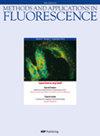利用最大熵法研究合成温度对β-NaGdF4: Yb3+、Er3+上转换发光效率和衰减时间的影响
IF 2.4
3区 化学
Q3 CHEMISTRY, ANALYTICAL
引用次数: 1
摘要
上转换材料由于其在将红外光转换为可见光方面的巨大潜力,在许多应用中具有几个优点。对于实际应用,需要实现高强度的UC发光,因此上转换纳米颗粒的最佳合成参数的研究仍在进行中,我们分析了合成温度对无水溶剂热技术合成的具有六方晶体结构的β-NaGd0.78Yb0.20Er0.02F4(15–25 nm)上转换纳米颗粒的效率和发光衰减的影响。合成温度在290°C–320°C范围内变化。合成温度对上转换发光效率和衰减时间有显著影响。相干散射域线性依赖于合成温度,在13.1–22.3 nm范围内,而在1 W cm−2激发下,上转换发光的效率从0.02%呈指数级增加到0.10%。为了从根本上分析上转换发光强度依赖于合成温度的原因,建议使用最大熵方法进行发光衰减动力学处理。该方法不需要预先设置指数的数量,因此,可以估计发光衰减动力学中的额外成分,这些成分归因于不同条件下不同的稀土离子群体。对于在290°C–300°C下制备的纳米颗粒,揭示了绿色发光中的两种成分和红色发光衰减动力学中的一种成分。绿色发光衰减动力学中的强短分量和弱长分量可能与表面猝灭层和晶核体积中的两种不同的离子群有关。随着合成温度的升高,第二组分消失,并且由于晶核体积中离子数量的增加和掺杂剂的更均匀分布,衰减时间增加。本文章由计算机程序翻译,如有差异,请以英文原文为准。
Study of synthesis temperature effect on β-NaGdF4: Yb3+, Er3+ upconversion luminescence efficiency and decay time using maximum entropy method
Upconversion materials have several advantages for many applications due to their great potential in converting infrared light to visible. For practical use, it is necessary to achieve high intensity of UC luminescence, so the studies of the optimal synthesis parameters for upconversion nanoparticles are still going on. In the present work, we analyzed the synthesis temperature effect on the efficiency and luminescence decay of β-NaGd0.78Yb0.20Er0.02F4 (15–25 nm) upconversion nanoparticles with hexagonal crystal structure synthesized by anhydrous solvothermal technique. The synthesis temperature was varied in the 290 °C–320 °C range. The synthesis temperature was shown to have a significant influence on the upconversion luminescence efficiency and decay time. The coherent scattering domain linearly depended on the synthesis temperature and was in the range 13.1–22.3 nm, while the efficiency of the upconversion luminescence increases exponentially from 0.02 to 0.10% under 1 W cm−2 excitation. For a fundamental analysis of the reasons for the upconversion luminescence intensity dependence on the synthesis temperature, it was proposed to use the maximum entropy method for luminescence decay kinetics processing. This method does not require a preliminary setting of the number of exponents and, due to this, makes it possible to estimate additional components in the luminescence decay kinetics, which are attributed to different populations of rare-earth ions in different conditions. Two components in the green luminescence and one component in the red luminescence decay kinetics were revealed for nanoparticles prepared at 290 °C–300 °C. An intense short and a weak long component in green luminescence decay kinetics could be associated with two different populations of ions in the surface quenching layer and the crystal core volume. With an increase in the synthesis temperature, the second component disappears, and the decay time increases due to an increase in the number of ions in the crystal core volume and a more uniform distribution of dopants.
求助全文
通过发布文献求助,成功后即可免费获取论文全文。
去求助
来源期刊

Methods and Applications in Fluorescence
CHEMISTRY, ANALYTICALCHEMISTRY, PHYSICAL&n-CHEMISTRY, PHYSICAL
CiteScore
6.20
自引率
3.10%
发文量
60
期刊介绍:
Methods and Applications in Fluorescence focuses on new developments in fluorescence spectroscopy, imaging, microscopy, fluorescent probes, labels and (nano)materials. It will feature both methods and advanced (bio)applications and accepts original research articles, reviews and technical notes.
 求助内容:
求助内容: 应助结果提醒方式:
应助结果提醒方式:


